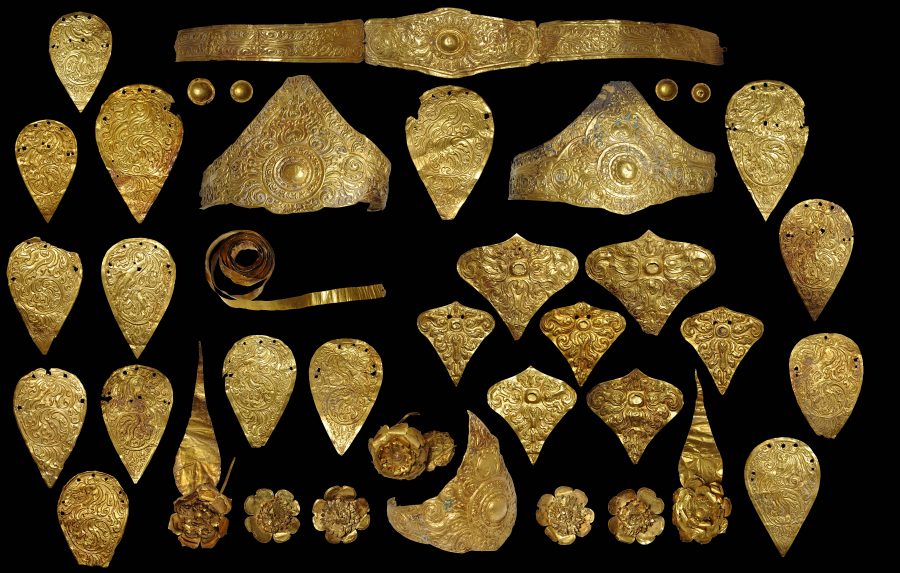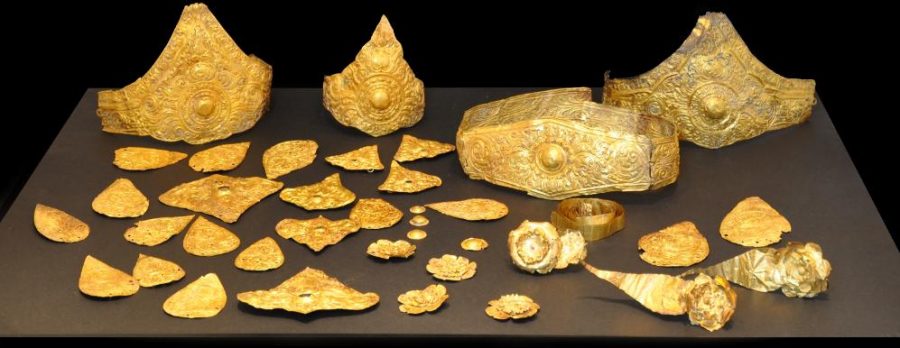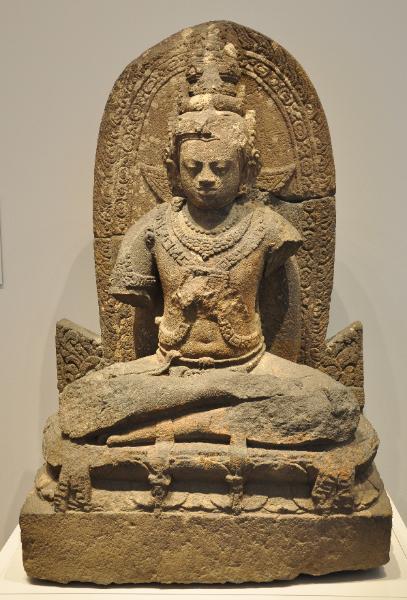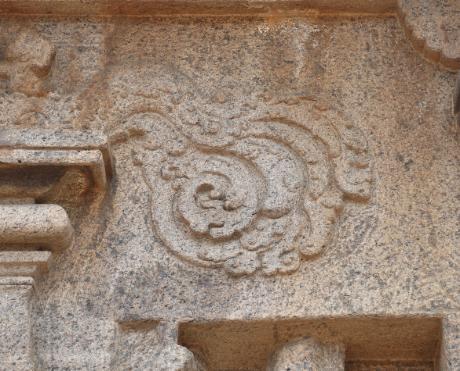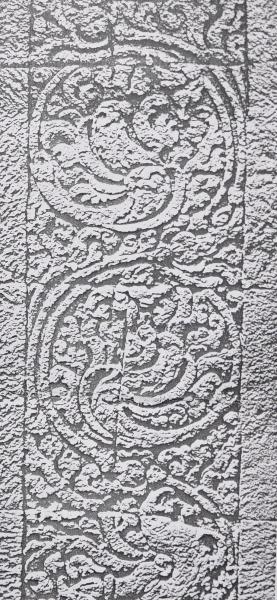Enquiry about object: 2221
Set of Inscribed, Early Classical Period, Javanese Sacred Gold Regalia for a King
Central Java, Indonesia circa 800 AD
combined weight: 770g
Provenance
previously in the collection of a retired European diplomat who served in Indonesia in the 1960s, but acquired after that time.
This extremely rare set of 38 gold ornaments appears to have been made initially for either a stone or wooden statue, but also would have been worn by a king or perhaps a queen. According to Bremer (2014, p. 11) on special days in 7th and 8th century central Java, kings and queens would adorn themselves with treasures meant for the gods themselves, and that such gold was created by only the best goldsmiths who were also deemed to have special spiritual powers.
The regalia could have been either Buddhist or Hindu. Buddhism and Hinduism seem to have peacefully co-existed in Central Java at the same time. A Buddhist image might be more likely given the motifs employed on the ornaments, as well as the fact that Buddhist images that have been excavated from this period overwhelm in number those that belong to the Hindu pantheon. However a similar set (though much smaller in that it comprises 18 pieces rather than the 38 here) was exhibited in Rotterdam’s Wereldmuseum in 2015 and was ascribed to a Vishnu king (see Bremer, 2014, p. 74).
The set is the most complete set known – each piece clearly relates to the others. The set most probably originated in the region of the Prambanan temple complex in central Java. The set has been assayed at just under 22 carats.
The set comprises 38 separate items. Included are:
– three large upper arm bands
– one articulated waistband or belt in three sections that have been hinged together
– seven prominent ‘chevron’-shaped elements each repoussed with ‘tree of life’ motifs, around a central box setting also in gold that would have contained a precious stone. The reverse of each has three lugs to allow the element to be affixed to the statue.
– fifteen leaf-shaped elements repoussed with scrolling lotus motifs. These are all pierced to allow them to be affixed, perhaps to a textile.
– four lotus flowers
– three jasmine flowers with stems and leaves
– one long, plain gold strip or chest cord that has been punched with an eighteen character mantra in old Javanese or kavi script.
The text on the strip has been deciphered by Dr Arlo Griffiths of the École Française d’Extrême-Orient as follows:
‘vratniṃ pailut• lavan• mauli su 2 mā 1 ku 2’
and the same scholar has kindly offered the following translation:
‘The weight of the pailut with the diadem: 2 suvarṇa, 1 māṣa, 2 kupaṅ’ (where the word ‘pailut’ may be taken to mean ‘belt’ or ‘girdle’).
Gold items from Java’s early classical period with inscriptions are extremely rare.
The historical context is important for understanding why the jewellery set was made. The Sailendra Dynasty kings were the main rulers of Java between 778 and the mid-ninth century. It was a period that lead to a flowering of Buddhism and Buddhist-related arts and architecture during the eighth end early ninth centuries. According to Lerner & Kossak (1991, p. 164), ‘Central Java, from approximately the beginning of the second quarter of the eighth century to the beginning of the second quarter of the tenth century, was the site of one of the most ambitious programs of temple construction known.’
The most extravagant example of this state-sponsored adherence to Buddhism came with the construction of the massive Borobudur temple complex in central Java in the ninth century. Images that appeared just after this period (ie from 850 onwards) displayed elements that had first appeared in India slightly earlier and reflect the influence of Vajrayana Buddhism. Accordingly, the five Cosmic Buddhas were represented with crowns and royal regalia, perhaps not unlike the gold jewellery here (Kinney, 2003).
The motifs employed on the ornaments here are very much of their time and period. The leaf-shaped elements are repoussed with scrolling Indian-style lotus roundels which have parallels in stone relief carving of the period, most notably to be found at the Borobudur temple complex, but also elsewhere in central Java, and also on other piece of gold of the period, such as a bowl found as part of the early 10th century Wonoboyo Hoard, now in the National Museum in Jakarta, and illustrated in Miksic (2007, p. 276). Green (2014) argues that such roundels, which are similar to designs employed on stone reliefs at Angkor Wat in Cambodia, most probably are influenced by roundel motifs on Chinese and Indian export textiles of the period.
The leaf elements, of which there are fifteen in the set here, is similar in form to one found as part of the Muteran Find, which was unearthed in Central Java during or just before 1881, and which today is believed to date to the tenth century (Hardianti & ter Kers, 2005, p. 57). The Muteran leaf element is punched with holes similar to the examples here to allow it to be sewn onto a textile or ribbon. It also incorporates the scrolling patterns evident on the elements here. It is believed to be part of a diadem to be worn on the head of an image.
Overall, the ornaments comprise an extremely important and early set of Central Javanese goldwork, and most probably the largest collection of gold items that relate to one another from Java’s Early Classical Period known today. The presence of a component with an early inscription adds to the set’s historical value and rarity.
The final images show:
(1) A volcanic stone sculpture of the bodhisattva Manjushri. The image is currently on display in Amsterdam’s Rijksmuseum and is from ninth century central Java – so is contemporary with the gold ornaments here. The jewellery worn by Manjushri relates to the gold jewellery in both form and decoration, particularly with the lotus scrolling. On Java, Manjushri was represented as a young man wearing straps across his chest. The fact that the gold ornaments here include a golden chest strap allows for the possibility that they were intended for an image of Manjushri.
(2) Some of the scrollwork on a temple structure at Mahabalipuram, near Madras (Chennai) on India’s east coast (photographed in December 2014). The temples dates to around the 8th century. Mahabalipuram was the port town of the South Indian Pallava dynasty. The temple is approximately contemporaneous with the central Javanese gold here. It can be seen that the scrollwork on the temple and the Javanese gold is similar. The influence of design from Mahabalipuram is not surprising given its seafaring and trade connections with the rest of Asia and even Southeast Asia.
(3) The scrolling Indian-style lotus form of the decoration on each of the fifteen leaf-shaped elements is very similar to the scrolling roundels carved in stone at the 9th century Borobudur temple complex in central Java, shown in the final image.
References
Bremer, S., Goud der Goden: Uitt het oude Java, Wereldmuseum Rotterdam Publishers, 2014.
Fontein, J., et al, The Sculpture of Indonesia, National Gallery of Art, Washington, 1990.
Griffiths, A., head, École Française d’Extrême-Orient, Jakarta, Indonesia, pers. comm., 2014.
Green, G., ‘Medallion patterns at Angkor Wat and Sumtsek (Ladakh): Origins and significance for textile studies,’ Arts of Asia, May-June 2014.
Hardianti, E.S. & P. ter Keurs (eds.), Indonesia: The Discovery of the Past, KIT Publishers for De Nieuwe Kerk, Amsterdam, 2005.
Kinney A.R. et al, Worshiping Siva and Buddha: The Temple Art of East Java, Univeristy of Hawai’i Press, 2003.
Lerner, M. & S. Kossak, The Lotus Transcendent: Indian and Southeast Asian Art from the Samuel Eilenberg Collection, The Metropolitan Museum of Art, New York, 1991.
Miksic, J.,Old Javanese Gold, Ideation, 1990.
Miksic, J.,Icons of Art: The Collections of the National Museum of Indonesia, BAB Publishing, 2007.


